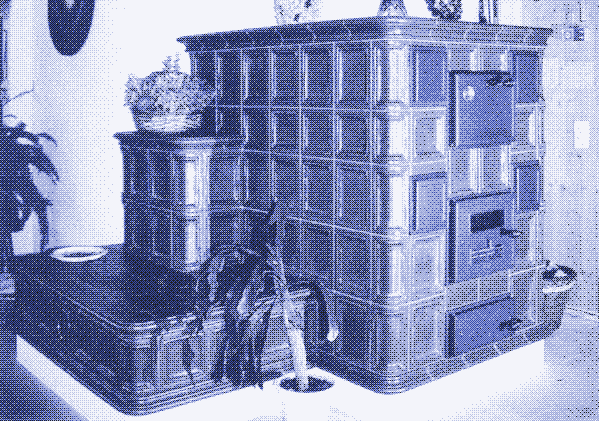
An oven stove is a very efficient and robust oven that radiates heat all day. In the US it was introduced only 20 years ago, but in Europe the technology is almost one thousand years old. Especially in Russia, Scandinavia and Central Europe the oven stove has a long and rich tradition.
In the 18th century, several European governments financed research to improve the technology, as a way to overcome an acute shortage of firewood: ecotech before the term existed. However, its further development and distribution was thwarted by the arrival of coal, gas and oil. Oven stoves are large, heavy and slow, but they offer so many advantages that they – again – deserve to be subsidized by the government.
Most people think that the metal stove was the successor of the campfire and the fireplace, and if you only look at the US, that is true. In the New World, there was never a shortage of firewood and therefore no incentive to improve the inefficient fireplace. But in Europe and Northern-Asia, there was an important and succesful link between the fireplace and the metal stove.
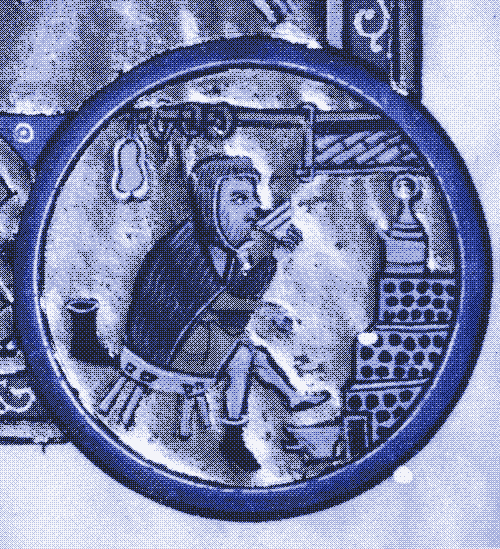
It is known as the Russian, Austrian, Finnish, Swedish or German stove, or as “kakelugn” (in Sweden), “pechka” (in Russia), “kachelöfen” or “steinöfen” (in Germany and Austria), and as “tulikivi” (in Finland).
More general terms are tile oven, brick oven, ceramic stove, tiled stove, soapstone heater or masonry heater. The technology is more closely related to a traditional oven than to a metal stove – therefore the German term “kachelöfen” (oven stove) describes it best as an umbrella term.
Oven stoves already appear on drawings and paintings in the 1300s (see illustrations above and below). They are in fact the first real heating appliances in history. Earlier, the Romans invented the hypocaust, a forerunner of central heating, but that knowledge was largely lost when their civilization collapsed.
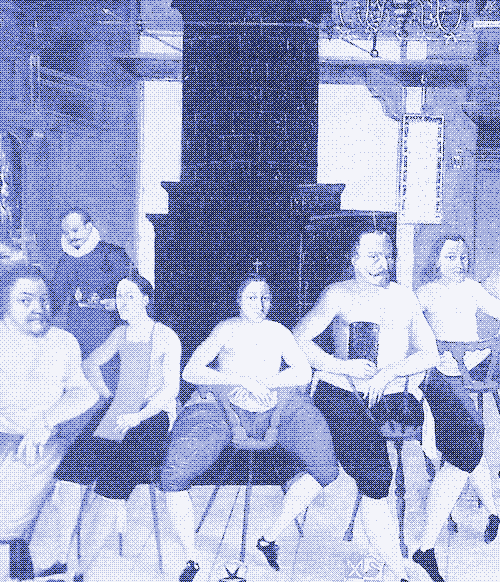
Oven stoves are traditionally fuelled on wood, but today they can also be equipped to work on gas, or alternately on both fuels. They can even cooperate with a central heating system. An oven stove can take any form or dimensions: it can be almost invisible, built into a wall or underneath the stairs, or it can be an impressive work of art standing in the middle of the living room.
Stone versus metal
The most essential feature of an oven stove is that it is made out of some kind of stone or brick, while all our modern heating appliances are made of steel. Metal heats up fast, but it also cools down just as quickly. Therefore, a metal heating appliance has to be fuelled almost continuously.
Stone requires more time to heat up, but once it has, it holds the heat much longer. An oven stove is only fired for a short time, from a quarter of an hour to one or two hours and only once or twice per day. An average oven stove then radiates heat for at least 12 hours.
Smoke channels
The main part of the heating appliance consists of a labyrinth of smoke channels and smoke rooms. Their aim is to hold the warm gasses inside the oven as long as possible, so that the stone can absorb the heat before it leaves the chimney.
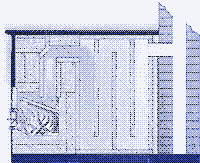
The energetic output of an oven stove is 80 to 90 percent, compared to 40 to 50 percent for metal stoves or central heating appliances, and only 10 to 15 percent for a fireplace – where most heat escapes via the chimney. One of the most striking features of a (wood fuelled) oven stove is the stokehold, which looks ridiculously small compared to the stove itself.
Thanks to the high output, a modest masonry heater or tile stove (heating a room of 60 square meters) only needs 6 cubic meters of wood per year: one tree. If you have even a small garden, you can easily fuel your oven stove by means of your own cuttings – thin wood is very well suited for tile stoves, although it needs to be dry enough.
Radiant heat
All our contemporary heating appliances warm a house or a room mainly by means of convection: they heat up the air. An oven stove does it by means of radiant heat: infrared radiation, comparable to the heat of the sun. In a room that is heated by an oven stove, a thermometer can hardly measure anything.
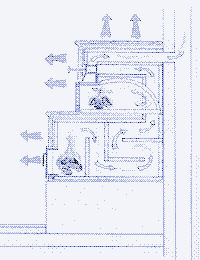
The effect is comparable to that of a skier who enjoys a schnapps while sunbathing, in spite of the freezing temperatures. Radiant heat does not (only) warm up the air, but particularly also the body of the skier directly.
An oven stove acts in the same way as the sun: it does not so much heat the air, but the floor, the walls, the furniture and the people in the room. These objects in their turn radiate that absorbed heat to their environment – similar to a city radiating heat after a long hot summer day, when the walls and the pavement slowly release back the heat from the sun.
This might sound a bit weird for 21st century computer wizards, but until 150 years ago heating was by definition radiant heating. Heating by convection is a very recent invention, and it has more drawbacks than advantages.
Hot air balloon
Convection causes constant air movement in the house, because hot air is pushed upwards (the principle of a hot air balloon) and cold air is being sucked in (all convectors need a constant supply of air). Warm air rises to the ceiling, while the people that it should warm find themselves on the floor. This is not very efficient. Moreover, it is always too hot close to the radiator or the stove and always too cold at the other side of the room.
Secondly, convection is not healthy. The dust in the house starts floating around, which irritates the respiratory system. In combination with the drying effect of warm air and by the scorching of dust by the metal surfaces of radiators and stoves, this leads to an unpleasant, alkaline air climate, which can cause headaches.
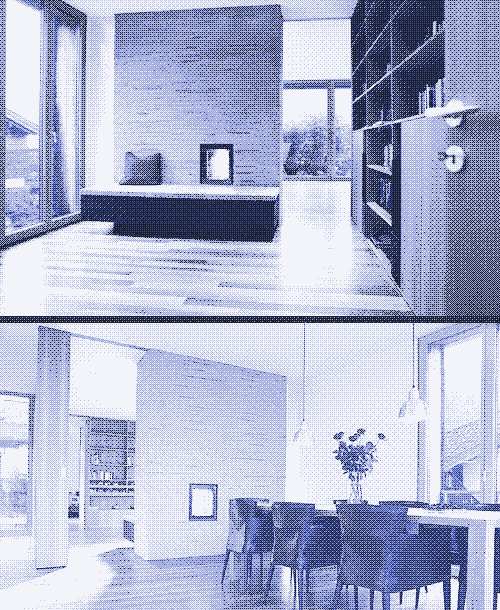
This problem is mostly solved by air humidifiers or electric water heaters, which blow a mix of steam and air into the room. Unfortunately, this creates the ideal conditions for house dust mite and for nasty fungii. You can not open a window to ventilate, because then the warm air escapes quickly.
Sleeping on the stove
An oven stove has none of these disadvantages. Because it hardly warms up air, there is no dust circulation. Because the surface of the oven does not become as hot as the surface of a metal stove or a radiator, there is no scorching of dust.
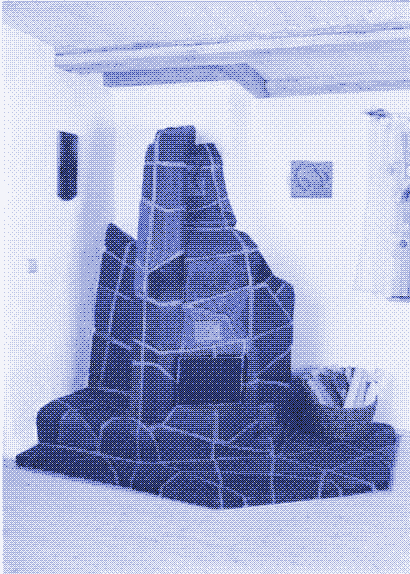
And because the air does not rise, the heat is distributed evenly across the room, instead of rising to the ceiling (or via an open staircase to the upper floors). This means you can open a window upstairs to ventilate the house, without losing energy.
Because the exterior of an oven stove does not become too hot, there is no danger of burning yourself. This quality is sometimes used to integrate a bench or a couch into the stove, a luxury that no other heating appliance can offer. In Russia it used to be a habit to install beds atop of an oven stove.
Thanks to their warm (but not too warm) exterior, oven stoves offer more possibilities. They are very well suited to keep pots and pans warm, or to dry laundry – metal stoves or radiators are mostly too hot for that. A ceramic stove can be equipped with hot plates and an oven, so that it can be used as a cooking appliance, too.
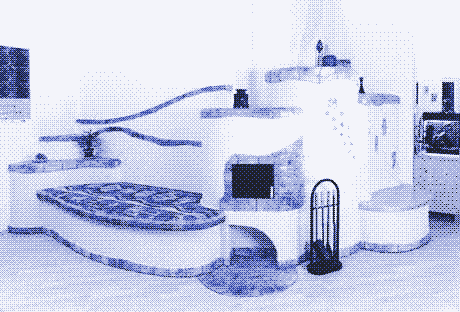
Complete combustion
Oven stoves are an alternative for all modern heating appliances, but compared to wood stoves they have another, important advantage. More and more people choose wood as an energy source for heating, so that they are not dependent on the unpredictable energy prices of oil and gas.
In one sense this is not a bad thing, since unlike gas and oil, wood is a renewable and CO2-neutral fuel (the CO2 that is produced by the burning of wood was taken out of the atmosphere by the tree during the years before). The problem is that wood stoves are not very efficient, and extremely polluting.
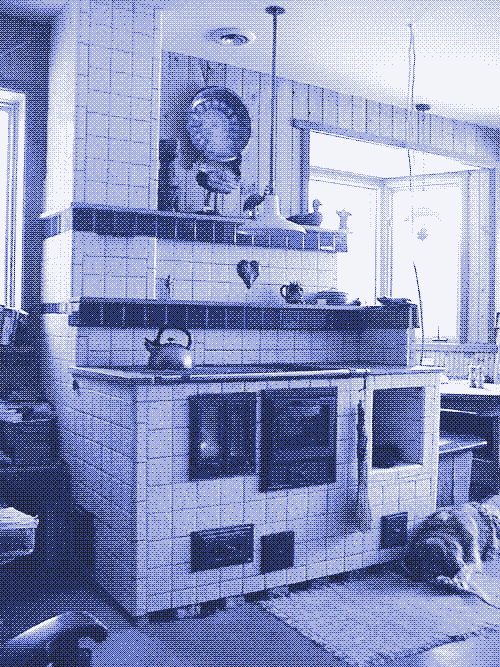
Wood can be burned without too much air pollution, but then the temperature has to be high enough: 1100 to 1200 degrees Celsius. In that case, 99 percent of the wood is converted to CO2 and water vapour, almost without smoke. A metal wood stove, however, only reaches a temperature of 650 to 700 degrees, with an incomplete wood combustion as a result.
Wood consists for two thirds out of combustible gases and for one third out of combustible material. In the case of an incomplete combustion, these gases escape as smoke via the chimney. In regions where many people use wood heating, the air quality worsens dramatically (an incomplete wood combustion is more polluting than the burning of oil or gas).
Overheating
In a wood stove the fire is quelled by diminishing the supply of air, if not the room would overheat by the fast release of warmth by the metal appliance. Because an oven stove does not immediately release the heat of the fire, but stores it temporarily in the masonry mass, wood can be burned at a very high temperature without overheating the room.
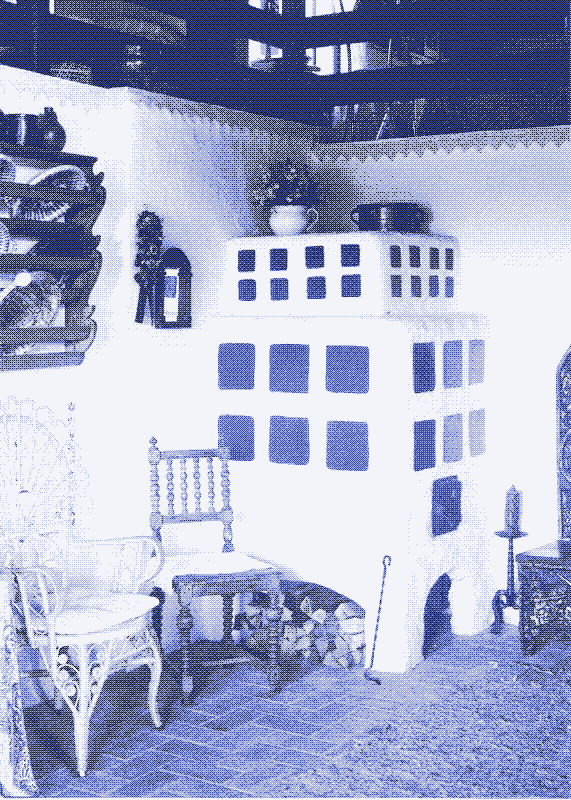
An oven stove is always stoked at full power, even if a lower temperature is desired: in that case you simply stoke a smaller portion of wood, or you stoke less often.
A complete combustion is not only advantageous for air quality and efficiency, it is also safer. In the case of an incomplete combustion, the chimney gets ever more densely set with creosote, which can lead to a chimney fire when one day the stove is fuelled at full power (the reason why a chimney has to be cleaned regularly).
Instant heat
Oven stoves have some disadvantages, too, although none of them are insuperable. Probably the largest drawback is the fact that a tile stove or masonry heater does not deliver the instant heat that we got used to.
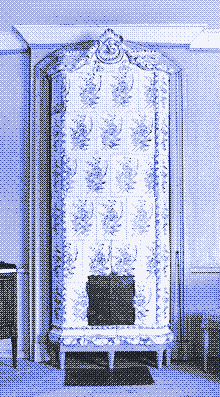
If you turn on the gas stove, you are almost immediately rewarded with heat. But an oven stove takes a couple of hours before it starts radiating heat. That is not such a problem during long, cold periods, because once the cycle has been started and the stove is stoked shortly each morning, the house is always warm.
It is less obvious during periods with large temperature fluctuations, or when you travel a lot. You can make the best of that, by dressing warm for instance, or in a less low-tech way by installing an extra heating appliance – like a gas stove – in the same room.
This second heating generator may also be a much smaller tile stove, or a ceramic oven (a small tile stove meant solely for cooking). The small one can then be used to heat up the room relatively fast while the large one is warming up. A tile stove equipped with two stokeholds, a big one for the heating and a smaller one for cooking, offers the same possibility.
Overheating
A masonry heater neither delivers the fine temperature tuning of other heating appliances. If a wood or gas stove is overheating the room, you simply turn it lower and the temperature goes down fast. With a tile stove, this is impossible to do.
If you burn too much wood or gas in the morning, this decision can not be reversed during the course of the day. There is no option left but to open the windows, and that is not so efficient anymore. Heating a room to the right temperature thus requires some practice and dedication, especially in a climate which is not like it is in Russia or Finland.
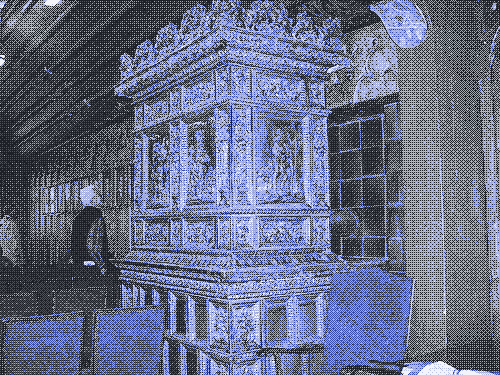
A third disadvantage of the tile stove is a consequence of radiant heat. An oven stove only heats the room where it is positioned. Opening the door will not warm up the room next to it, because it is largely lying in the “shadow” of the radiant heat.
This is again comparable to a warm sun on a winter day: if you step out of the sun into the shade, the radiant heat is gone and all you feel is the air temperature. A gas or wood stove does not perform too well on this either, but a central heating system seems to be the indisputable winner. However, a tile stove does not exclude a system of central heating.
Heat walls
Heat walls or heat floors are another way of applying radiant heat. Here, warm water is not led through plate steel radiators as in a conventional central heating system, but through plastic hoses which are integrated into the walls (or into fake walls). Because of its porous surface a stone wall can not heat up air, it radiates like a tile stove.
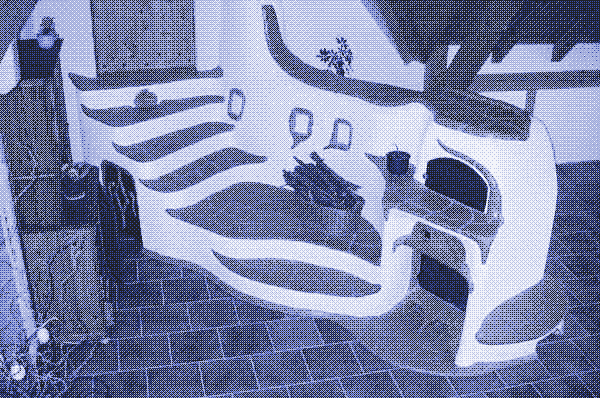
Heat walls can be combined with an oven stove. The stove is connected to a boiler system, which distributes the warm water via hoses in the walls or the floor throughout the house. In this way one tile stove (assuming it is powerful enough) can heat up all rooms in a house, something which is otherwise not possible. In the same way a tile stove can deliver warm water for a household.
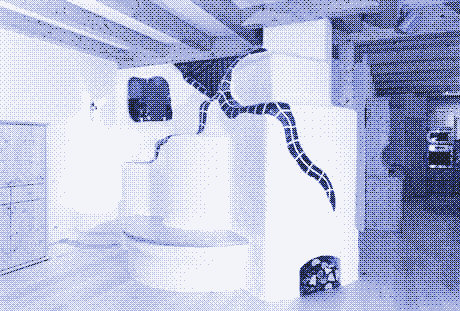
Heat walls can also be combined with an existing central heating appliance. This is already a step in the right direction, because the energy consumption goes down (the water does not have to be as warm as in the case of a traditional central heating system, because the heat is radiated over a larger surface area) and you get a better interior air climate.
As a third possibility an oven stove can also be connected to a network of metal radiators (as in this church), but in that case you lose the advantage of radiant heat. Steel plate radiators warm up the air.
Heavy, bulky and expensive
Another, quite fundamental drawback is that oven stoves are rather big and heavy. A modest tile stove amounts to at least 800 kilograms, and big ones (especially in the US and the former Soviet Union) can weigh up to 5 tonnes, or more. Smaller models exist, but they lose some advantages compared to their larger brothers (they have to be stoked more often, and do not always reach a complete wood combustion, or the same energy efficient output).
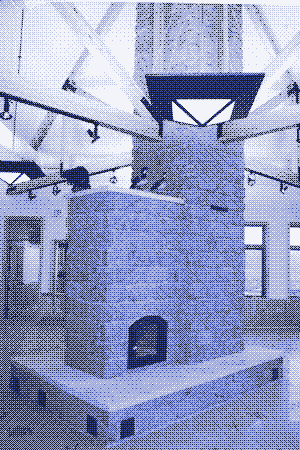
A masonry heater needs to be large and heavy, there is nothing one can do about that. Metal heating appliances have the indisputable advantage of being compact.
Masonry stoves also cost 2 to 3 times as much as other heating systems. Since the energy consumption costs are lower, and a well-built oven stove lasts a lifetime, this investment pays itself back after a while. However, you have to be able to afford the purchase.
In Finland, a major producer of soapstone heaters, the purchase of an oven stove is subsidized by the government, with the consequence that 90 percent of new houses has them inside.
Oven stoves are expensive because they are products of craftsmanship. They are not really suited for mass production (although efforts are being made), and are therefore not of much interest to the heating industry. They prefer to sell, for example, pellet stoves.
Pellet stoves
A pellet stove is the only wood stove that reaches a complete combustion like an oven stove does. Sophisticated technology is used to accomplish this – which is also the weak point of this heating system.
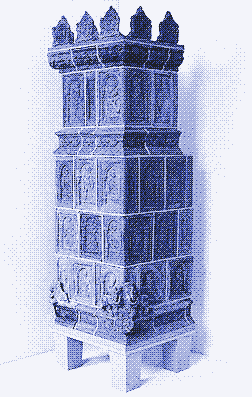
A pellet stove needs electricity to power all the high-tech (conveyor belt, ventilation, temperature regulation, and so on), which means that this electricity use should be taken into account when calculating the environmental score. Furthermore, a pellet stove stops delivering heat when there is a breakdown.
A pellet stove can only be fed with pellets, small rods made of wood, which are processed in a factory. Pruned wood or sawed wood are of no use in a pellet stove. Producing these pellets requires a lot of energy.
Another consequence is that once again you are dependent on the unpredictable prices of an energy supplier. Also, a pellet stove mainly heats up the air and hardly emits any radiant heat, so there is no health advantage compared to a wood stove, a gas stove or a central heating system. Thanks to all the high-tech inside, however, a pellet stove costs as much as an oven stove.
Fake oven stoves
Now that oven stoves are gaining some popularity again, the manufacturers of metal heating appliances try to get a slice of the pie. A few have started offering them according to traditional methods, sending masons to your house to build whatever oven stove you desire.
Most manufacturers, however, now use radiant heat as a greenwash promotion strategy. There are now stoves on the market that look like an oven stove, only they are not. They are normal metal stoves, wrapped in tiles. They betray themselves by grates to let in cool air, something an oven stove does not need (see picture below).
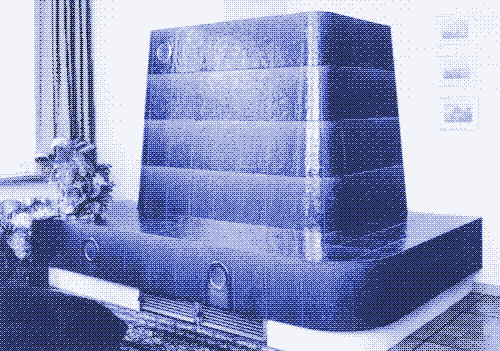
Of course the tiles get hot when the stove is running, but they cool down just as fast when it is turned off. These appliances are promoted as an ideal combination of both technologies, but they are simply convection stoves. They hardly emit any radiant heat, they scorch dust and they have a lower performance. Yet, they sell.
Another example is this German wood stove, pictured below. It is enthusiastically being promoted as a modern variant of an oven stove, and it will appeal to steampunks and survivalists, yet this is just a plain wood stove, not very efficient and very polluting.
Burning the woods
The oven stove is the only technology that allows a clean burning of wood without the need for another energy input, and thus it is the only technology that promises an environmentally friendly alternative for the dwindling resources of gas and oil.
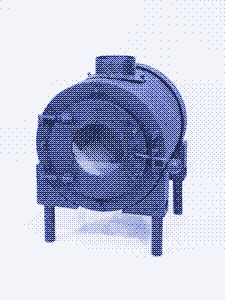
The crucial question is whether the earth can produce enough wood to keep a significant amount of people warm. Today’s energy crisis is not the first in human history. Starting in the 15th century, some countries in Europe already faced a serious shortage of firewood and this became an acute problem in the 17th and 18th century, which only got “resolved” by the arrival of coal.
It seems impossible that the present European population could again be warmed by wood, because there are now many more people than in those times. But there is some hope that the potential is larger than expected.
The massive deforestation in the Middle Ages was the consequence of the fireplace, which needs ten times as much fuel as an oven stove (wood was also the main construction material). Even though the tile stove is almost 10 centuries old, it only broke through on a large scale in the 19th century, and even then only in some European countries.
The potential of the technology was never fully developed because of the start of the industrial revolution, and the abundance of coal. Research has yet to reveal how large the potential of wood as a fuel can be if we would use oven stoves, but it is surely greater than if we would return to wood stoves.
Thanks to De Twaalf Ambachten
Image credits :
- Medieval oven stoves: Furnologia
- Russian oven stoves: Kuznetsov’s Stoves / Flickr: 1 & 2
- Swedish oven stoves: Stockholms Läns Museum
- Swiss oven stoves: Albert Iten
- Irish oven stoves: Biofire - German & Austrian oven stoves: Bernthaner & Co / LEHMO / Peter Nikol / Flickr
- American oven stoves: The Masonry Heater Association of North America / Gimme Shelter Construction / Masonry Stove Builders
- Graphics: here and here.
Reactions
To make a comment, please send an e-mail to solar (at) lowtechmagazine (dot) com. Your e-mail address is not used for other purposes, and will be deleted after the comment is published. If you don’t want your real name to be published, sign the e-mail with the name you want to appear.
Reactions
Nic M
Very interesting! I had never heard of oven stoves before, but now I really want one.
Uncle B
Post (GRD) great republican depression life in the U.S. will see people huddled in smaller quarters around waste product burning stoves in wintertime. The internet has provided here, another means of survival in those days. The uber-rich will still have everything the 20th Century American citizen had, but a new class of people will not! This new class will be forced by economics, to live a more communal lifestyle and will include ovenstoves, solar, wind and wave power in their arsenal for survival. Old tires will prove an effective fuel, as will pieces of asphalt, broken furniture, waste oil and even dead carcasses. High tech computer based computer programs will help judge the amount of fuel needed daily, and feed-back items like thermistor based temperature devices will yield all the necessary data. This new class will be a very sophisticated well educated, computer and electronics savvy, biotech using, class, and will eventually overcome the uber-rich as accumulated wealth from earlier times is used up, and will develop a greener sustainable renewable way of life for all survivors! America is in for cataclysmic paradigm shifts and ovenstoves will play an important role.
jaap
You know,I dont know how to explain this shortly…
But the thing I miss here is “planting willow trees”.they grow extreemly fast and produce good firewood. NOW we are talking real C02-neutral heating.
Somebody please make a link to these english monestaries where they’ve been heating with willows for ages.
Ed Magowan
This meshes well with another interest of mine, woodgas stoves / generators. I no longer live in a climate in which an oven stove would be useful but that may not always be so. I cook with a woodgas stove and hope to build one capable of running an electric generator.
Marjaana
“In Finland, a major producer of soapstone heaters, the purchase of an oven stove is subsidized by the government, with the consequence that 90 percent of new houses has them inside.”
I was wondering where you got that figure. 90% seems wildly exaggerated - even if you include pellet stoves, open fireplaces and the like.
kris de decker
Here is the answer from Tilastokeskus, the Finnish office for national statistics:
“The Finnish government does not support the installation of oven stoves in Finland. We have no figures of how many new houses are equipped with oven stoves nowadays. In 1990 the figure was somewhere around 75 percent of new houses (unofficial figure from an official of Ministry of Environment). By the way, ’tulikivi’ is a trademark. A better Finnish word is ’tulisija’ or ’takka’. Best Regards, Kirsi-Marja Aalto.”
http://www.stat.fi/
Thanks to Klaas Van Gorp for bringing me in contact with the right person.
Robert Speirs
Nothing “deserves to be subsidized by the government”. That is the surest way to kill any development. And if it were “deserving”, that is, worthwhile, why would it need other people’s money, taken from them by the government at the point of a gun, for it to be useful and helpful??
Ric Locke
The other advantage of a tile stove is that the stokehole need not be indoors. This means that the servants can feed the fire from outside, or from an adjacent room, and the Prince can be warm without having firewood carried in and ashes out over his beautiful carpeting, not to mention avoidance of dealing with the lower orders. Ludwig’s castles are full of that type. No doubt Uncle B’s will be also, when he gets that far along.
Regards,
Ric
Roberto
A oven stove does not heat by infrared radiation. It is a radiant heat source (like an old style water filled radiator), but the exterior temperature of the stove is not enough to generate any real infrared radiation (goood thing, too: a stove that hot would be an incredible danger to people, especially kids :-)
Those things you put in your patio (fired by GPL) heat by infrared, but they are glowing hot…
Penn
I’m not sure why commenter #11 believes that these stoves do not heat via infrared radiation, because they definitely do. Long-wavelength IR if we’re to be more specific. The LPG heaters with glowing elements emit radiation with about 1/3 the wavelength of that emitted by masonry heaters.
Noneb4
Loved this post but Robert Speirs comment #7 was exactly right. Government is the surest way to destroy a working economy. Individual rights must be respected–and this is the best way to help the lowest income earners as well. Give them a chance to rise out of their poverty. Do not steal from those who provide them that chance. Don’t kill the goose that lays the golden eggs.
Eric H
The comment at 11 is wrong. Infrared radiation is generated by all black body radiators with a temperature greater than 0 K. Comment #12 is correct, something which is hot but not visibly glowing is emitting a great deal of IR energy in wavelengths longer than those visible to the human eye. The energy emitted by a black body forms a continuous curve with a recognizable peak. Regardless of where the peak is, the energy as a function of wavelength is a continuum. As I recall, the Planck curve corresponding to room temperature (~300 K) peaks at about 9 microns, which is considered to be “long wave IR” (LWIR). The peak moves toward shorter wavelengths as the temperature increases. The Planck curve corresponding to the sun (roughly 6000 K) peaks at around 0.5 micron, well inside the visible range (roughly 0.400-0.800 microns).
See the Planck curves in this article:
http://en.wikipedia.org/wiki/Thermodynamic_temperature
Note that black body radiators and line emitters (such as gas combustion) are different.
I would also agree about the subsidies. Far more useful than subsidies would be changes in building codes that would allow for alternative methods like this, as well as reuse of grey water, etc.
Tom
I happen to know the German wood stove product featured last. It has a computer controlled air intake, leading to a very efficient combustion process with little wood required. The system is also modular, supporting cooking, water heating and thermal storage.
Mark McClure
You know, I’m surprised by the idea that Americans didn’t go for this type of stove back in the woodburning days. Sure, firewood may have been plentiful back in the pioneer days, but it takes a lot of somewhat dangerous work to cut, split and stack wood. You’d think the efficiency of this stove would outweigh the cheapness of the fuel.
Brian
Korean Ondol under floor heating is traced back as far as the Bronze Age. When I was stationed there, I LOVED my apartment’s steady and even heat! Although mine was oil fueled, older small outdoor charcoal burners worked surprisingly well using just a very small stove and fitted charcoal round “bricks.”
Pangolin
These masonry heaters are perfect companions to TLUD (top-lit, up-draft) wood gas stoves. The TLUD prefers to burn wood chips and finger thick branches that are usually referred to as yard waste in the US and are therefore free. Literally, huge piles of woodchips are left around my town by the city’s tree pruning crews to be spread as mulch.
The TLUD stove burns very clean as tars are destroyed by a bed of hot charcoal above the flame front. What emerges from the top is hot producer gas that will burn if provided with a supplemental oxygen source.
Combine the hot clean fire of a TLUD with the large thermal mass of a masonry heater and you have the ideal heating appliance; a clean, efficient, heater, that works with free fuel. How sweet is that?
Dave P
If one is to use wood as a heat source these would definitely be better than conventional wood stoves in the US and Canada. Although I would probably not recommend wood burning as it has been identified as a major air polluant. Montreal had its share of bad air quality this past Winter!
gigi
In Romania they are very popular also. They are called SOBA DE TERACOTA. And they are heated by wood or gas, especially in cities. There are a lot of companies with a lot of experience which are producing “cahle”; these are the tiles in many shapes and colours. But most important are the special bricks you put inside, the name is “shamota” (chamote) this is what keeps the heat for a lot of hours.
This winter, for example, especially in the middle of Romania it was vey cold, about two weeks of -32C, but the people were not afraid because they had enough wood stock and they heat their homes by “teracote”.(kachelofen, tiles stove)
Peter
My wifes family in Ukraine had two of these stoves that they used to heat the house. Sadly, a few years ago a natural gas line was run through the village and they dismantled the stoves and started heating with gas. I told them to leave the stove as they might need it, but lighting it is a chore that you don’t have when you can just crank up the gas heat. I don’t forsee the stoves being used in North America for the same reason. The reason conservation is not so widespread is because companies don’t make money from conservation.
Sasha
http://www.appropedia.org/Masonry_stoves
Here is the short article with very useful links on stoves. I do build (assemble them is more appropriate term). It is very very physically demanding job. I need to build one this or next week for a friend.
Sasha
T U
Just a minor linguistic correction; The website states “the German term “kachelöfen” (oven stove) describes it best as an umbrella term.” Actually, Kachel in German means tile, so “kachelöfen” would be tile-oven.
I lived in West Berlin in the late 1970’s in an apartment with a “kachelöfen” as the only heat source. We heated it with coal bricks. Each apartment in the building had a small space in the basement to store these coal bricks. The coal bricks were delivered by truck into a chute opening onto the street. Also, there was no hot running water. Instead, there was a five liter tank above the kitchen sink that was connected to the cold running water source. After filing this tank you could press a button to bring the water to a boil (using electricity) and then mix it with the cold running water. Many people lived in such apartments at this time.
Ben
There was a story in Britain’s Daily Mail newspaper about them a while ago mentioning the efficiency of them. Apparently the man who built it was born in Eastern Europe.
Justin
There is one more type of efficient wood stove: the rocket mass stove. It uses the same principles, but the heat is stored in cobb benches or walls that the flue passes through. (Cobb is a composite of sand, clay, and straw.)
The only source I’ve been able to find is a book called Rocket Mass Stoves: Super-efficient Wood Stoves That You Can Build by Ianto Evans.
I am not affiliated with the author, but I am building one. Total cost for mine will be less than $50 USD.
oldbrownhat
I keep coming back to this article as the idea seems very sensible, esp. for rural living, although I have already built my house and it is not really retrofittable to a masonry heater.
One thing that occurred to me was “how do you clean out the flue” with that complex smoke path? Perhaps the combustion is so complete that there is little build-up?
Clara Vass
In Central-Europe, in Hungary the oven and the glazed-tile stoves has a rich and long tradition, too. I suggest the home-pages: www.majorkandallo.hu and www.vilmos-kalyha.hu - a builder of glazed-tile stoves and traditional ovens and a designer and an owner of a glazed-tile manufacture.
Jim
I use a masonry stove myself, and I like your site, but I disagree that a basic need to heat a home needs to be “subsidized by the government.” I built my own stove and paid for it myself, and I’ll be damned if I think it right to bilk my friends and neighbors for my own personal benefit. We do not own each other.
Myrtonos
What about Geothermal heating?
hugh owens
In our old log cabin we recently replaced the antique wood cookstove with an Amish built “kitchen Queen cookstove and we placed about 1000 lbs of concrete paving blocks around the perimeter . The stove itself bakes beautifully, cooks better than a gas or electric stove and heats the heavy mass of concrete such that it is still warm in the morning. It heats our house wonderfully. It is a long way from an oven stove but it was a wonderful purchase. We bought it from a dealer in Montana.
Leon
We have lots of these in the Northern Finnish houses where the temperature gets as low as -38C in the winter. The heat that radiates from them is amazing and lasts long after the fire is out.
Rob
The article mentions the fact that these stoves are expensive and require craftsmen to build. Might I suggest the Cob stove? Inexpensive, and a careful beginner could build a stove over a couple of weekends. http://www.richsoil.com/rocket-stove-mass-heater.jsp
Marianne
I loved the article! Rob (poster above) is correct, the rocket mass heater would be an inexpensive alternative to the gorgeous stoves in the article.
David Remus
“If a wood or gas stove is overheating the room, you simply turn it lower and the temperature goes down fast. With a tile stove, this is impossible to do.”
“A third disadvantage of the tile stove is a consequence of radiant heat. An oven stove only heats the room where it is positioned. Opening the door will not warm up the room next to it, because it is largely lying in the “shadow” of the radiant heat.”
If you placed the stove in the center of the home with the walls dividing the rooms radiating out from the stove, thereby dividing the home into quadrants of heated space and effectively having multiple heaters, you could selectively heat rooms by covering them partially or wholely with an insulating panel. The heat NOT radiating out into an unused room would translate into a longer heating time into the rooms being used.
And overheating is a problem easily solved. If you simply cover part of the oven stove with any insulating material heat resistant enough to not degrade, you have effectively reduced the size of the radiating surface to whatever level you are comfortable with. The side effect is a longer heat time.
The material could simply be a thick wool blanket, or any such insulating material so this solution could be applied to a stove built hundreds of years ago for the price of a couple of nights out. Even aluminum foil would reduce the radiation.
Infrared reflects off of certain materials so heat CAN be directed into another room. Overhead and over the wall, etc.
David Remus
Clovis, CA
Fernando (Ph. D. Engineering)
Nice article but the thermodynamics of heat transfer is a bit muddled. Comment 14 is addressing the relative wavelength distribution of the light emitted by a blackbody object. He is neglecting the Stefan-Boltzmann Law that states the radiative heat emission per unit area of an object is proportional to the temperature of the object to the fourth power. The net radiant heat transfer is proportional to the fourth power temperature difference between the object and its surroundings. Roberto is correct that colder higher surface area stoves transfer more of their heat by convective and conductive processes (molecular collisions) than radiative processes. If you assume a stove surface temperature of 50 C and a surroundings of 15 C, an emissivity of 0.9 for brick you get a radiant heat transfer rate of approximately 200 watts per square meter, this is too low to account for 90% heat transfer for stoves that have outputs of 15 to 20 kW, even with 10 square meters of surface area. For a hot surface ( iron) stove at 250 C the radiant heat transfer rate is 3500 W/ m2.
Delorus
I looked into having a masonry stove put into my house when we built in 2007 but here in lower Michigan I couldn’t get a quote from a builder of masonry stoves for less than 15k, and the place wasn’t too responsive even at that. With the baffles it didn’t look like any home project either for a first timer. So I got an efficient soapstone wood stove for 1/3 the cost.
Mrs. C
I want one. Does anybody in Arizona, USA build them?
Debra Callahan
http://www.mha-net.org/certified-heater-masons/ Matt Helicke built one in So. colorado for us. We love it. So worth the cost. I have sinus problems and it does not dry out my sinuses like gas forced air or wood stove. We would have cut anything else in tne house in order to keep the heater. We have a bake oven I use every day.
Fireplace lover
As mentioned earlier, Tulikivi is trademark and not general term for this apparatus. Neither are tulisija or takka any better terms because they describe more open fireplace. Actual finnish name for this is ‘kaakeliuuni’ or ’leivinuuni’.
Kaakeliuuni is for heating only and leivinuuni is for making baking bread and other foods on top or inside the thing - as well as for heating.
Pretty much every old and modern house in Finland has at least a fireplace. Some fireplaces circulate heated air around inside heat absorbing elements around the fireplace or even under the floor using a heat exchanger before it leaves the house.
My understanding is these oven stoves are coming back and are built more and more into new houses. Which is nice.
Bill
This is how rocket mass heaters (RMH) work. They heat the home by heating the mass, which radiates heat long after the fire is out. Rocket mass heaters can be built by the home owner fairly inexpensively, require much less fuel than metal stoves, and burn so efficiently that no visible smoke comes out the flu after it has come up to heat.
Another article featuring rocket mass heaters would be in order, I think.
Slowburn
lf I were to take a small steel stove and 10 odd meters of mostly corner chimney ducting making a convoluted route for the smoke to take before reaching the existing fireplace chimney then bury the whole thing in earth, I would have one of these oven stoves?
Larry
I have a friend who built these stoves into two homes in upstate New York. With the right room layout at the time of the build they can heat every room in the house. He still uses it as his main heat source after 30 years.
Marko
Hey Kris, a long-time reader here!
As a tile stove enthusiast and a long-time user of one, I loved this article since it came out, and have finally decided to give my input.
So, I grew up in Croatia in a compact 1950’s apartment with a wood burning tile stove in living room. The stove was about 1.6mX1mX0.6m in dimensions, we call them “Kaljeva peć” and they are very, very similar to DDR-period Kachelofen.
Based on this, i’d like to fill in on some things you mentioned.
Perhaps for some super big ovens it takes longer, AND when the stoves are NOT CLEANED (or made in a bad way) you have problems with heat transfer.
however, this isn’t fault of technology itself and i have to make this clear!
for example, a few years back i was bunking over at one place in Berlin which had a similar stove. however, it simply wouldn’t get hot although draft was good and i fired it a lot. why? because i recognized the inner flues were dirty and partially clogged.
these stoves CAN (and WERE) used to heat the entire apartment of 56m square. you do this by simply keeping doors of other rooms open, and while rest of apartment isn’t as hot as the room with the oven, it’s temperate enough to be comfortable with a bit of normal winter clothes, like a sweater and wool socks.
the heat isn’t only radiant, it really, objectively rises the indoor temperature because the radiant heat heats up furniture, walls, etc.
ADVANTAGES
Aside of the advantages you mentioned with less dust (i can attest to that being true) and of “healthier heat” (my cousin and grandparents always loved our stove and they lived in a place with central heating), the two biggest advantages of these stoves from my standpoint are fuel flexibility and fuel autonomy.
FUEL FLEXIBILITY - you don’t only use firewood but can burn essentially any wood inside. I sometimes collected park wood which was cut in neighborhood. you can use wood debris or cuttings from a sawmill, or coal, wood briquettes, all work fine on a well built and maintained stove. also, you can give (or be given) some fuel by your neighbors in a pinch. you can’t do that with electricity.
FUEL AUTONOMY - you prepare the firewood for winter beforehand, in summer. especially if you’re on poorer side, you will have time to plan your finances, see your options, and have time to cut and stock everything up. so, when winter comes, you know you’re set. compare this with gas heating, which you need to pay on spot, and where you are dependent on price the provider dictates! such ovens are a blessing for low-income people!
I’d like to touch on the stoves being complicated to build. most stoves are indeed a bit challenging as you have to make complicated flues, have special firebricks, mortar and etc.
so, what are the options for interested people without a big budget, access to craftsman or a lot of skil? well, firstly, don’t go by the stoves you see if you type “masonry heater” in google, they’re too complicated to build and also ridiculously big.
and also, dont be discouraged,because there are a couple of options:
a double bell Kuznetsov stove. it’s very simply designed and still retains a lot of heat.
brick cookstove/heater: google “sesselherd” for Austria or “sparhelt csikótűzhely” for hungarian examples. Austria and Hungary have great designs.
in many pannonian villages you have simple mud stoves (google “bubos kemence”) which are stoked from outside with whatever is available, including corn stalks, reed, hay, brush, cleaned corn cobs, etc. and that can be interesting on a homestead. these stoves are made by rolling clay cylinders on a wicker frame and are essentially a large, tall bread oven. there are pictures and videos online and it’s not really rocket science.
your room will be a mess for a couple of days when building it, and you will have to let the clay dry for a month or so before first stronger firing. also you will need to apply and renew each year an inner protective layer of the stove made with a mix of clay, horse manure and shavings so it doesn’t start smoking up the room. but if you do that, they can last for 50+ years and are pretty cheap and simple to build, can be fired with agricultural waste and you need to fire them up twice a day, or three times if it’s really cold!
Good luck to everyone trying to built their own! I can only recommend it!
Stefan Erb
Thanks, Marko,
for your great comment.
I totally agree.
I think, Kris, you saw the oven stoves worse than necessary and than they actually are. That speaks for your honesty and extensive research. Well done!
I’m not so sure about the combustion quality of a rocket mass heater, as the fire doesn’t achieve a high temperature firing only little sticks.
John Wesley-Knox
Slowburn: Based on a number of presuppositions (which may or may not be warranted), I would say, “In principle, I think you would”.
Tobias Boyd
A great read, though I was surprised not to see any mention the Chinese kang: https://en.wikipedia.org/wiki/Kang_bed-stove
Angus
Just a couple of sources for more info about rocket mass heaters, as some of the comments were looking for. https://permies.com/w/rmh-resources (a great starting point as they link to lots of other rocket mass heater resources) https://freeheat.info (info about rocket mass heaters, a movie, and plans - things like a rocket kiln, sauna, and regular heaters) Rocket mass heaters are incredibly efficient, with minimum inputs (both materials and labor) and can be built yourself, so often very cheap to make and run. They are also good for the planet with a clean burn, minimal use of materials and made from natural and often recycled products. And they can be good for community building, not only through projects to make them but also as they often have a long bench built into them (the mass) which is conducive for gatherings/socialising. It would be great for more people to find out about them, especially as so many are struggling right now with the cost of heating conventionally. Hope this helps!